This post shares everything you need to know to prepare for a visit to Manuel Antonio National Park. We’ll cover all the complexities of buying your ticket, choosing your time slot, going solo or with a guide, plus a ton of other helpful information.

This article may contain affiliate / compensated links, that may earn me a small commission, at no extra cost to you. For full information, please see our disclaimer here. While all efforts have been taken to ensure the information included in this post is correct and current, travel information such as opening hours, business operations and prices change frequently. If you find anything in this post that is incorrect or outdated please let me know in the comments so I can update it for other readers.
About Manuel Antonio National Park
Manuel Antonio National Park is Costa Rica’s smallest, but most popular national park.
At just 16 km² (6 mi²), this small area is a surprisingly wonderful place to see wildlife. The park also boasts miles of trails and some of the country’s most beautiful beaches – what’s not to love?
But a lot of people hate Manuel Antonio National Park. Likening it to a natural Disneyland, that is overcrowded, an exploitation of nature and a rip-off.
As someone who is sensitive to overtouristed destinations, unsustainable tourism and crowds, I was hesitant to visit.
But it was the campaigns of travellers who swore black and blue that despite the crowds, Manuel Antonio was one of their favourite places in Costa Rica that convinced us.
And boy am I glad we didn’t waver to the negative feedback! We loved our time at Manuel Antonio, and strongly believe it is a must-visit in Costa Rica.
Often the people complaining about the park are the ones who didn’t properly do their research. Who didn’t follow instructions to buy their tickets in advance, didn’t arrive early to beat the crowds and didn’t come prepared with the right things in their bag.
So, in this post, I’m going to share everything you need to know about visiting Manuel Antonio National Park, to make sure you have an enjoyable time in one of Costa Rica’s most beautiful natural areas.
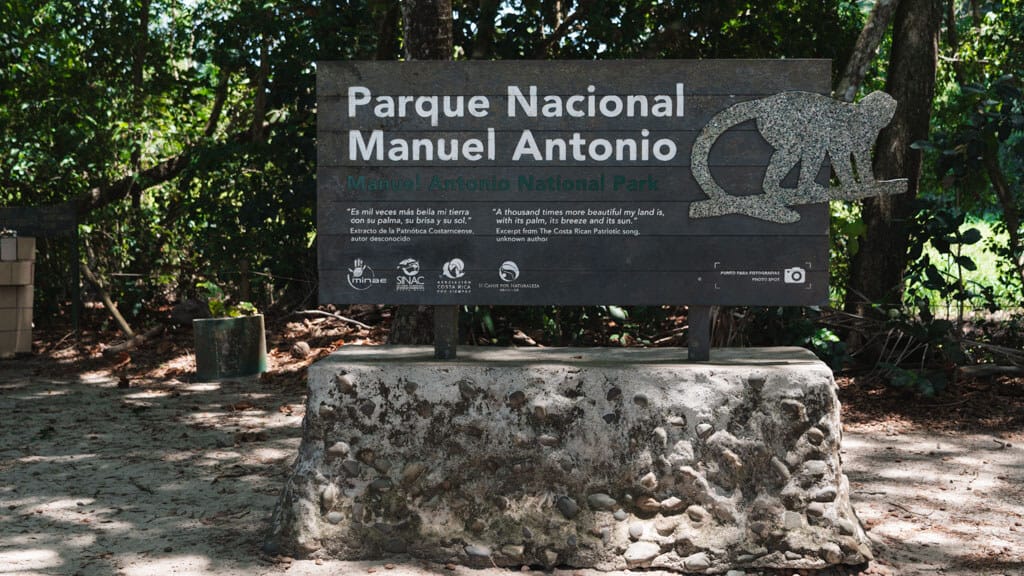
The essentials
- The park is closed on Tuesdays
- You must buy tickets online in advance via the SINAC website
- Tickets cost $18.08 USD for adults, $5.65 USD for children
- Purchase them ASAP as there are strict capacity limits
- Visitors must choose an entry slot, the first is 7:00 am – 7:40 am (recommended)
- A guide is not mandatory but can help spot wildlife
- 11 trails to hike, hiking boots are not required
- Pack swimwear and a towel for the beaches
- Restrictions on what you can bring into the park, including some foods
Where is Manuel Antonio National Park
Manuel Antonio National Park is located on Costa Rica’s Central Pacific Coast, in the town of Manuel Antonio.
A lot of people don’t actually realise there is a town, as well as a national park with the same name.
The town of Manuel Antonio lies between the national park and the larger town of Quepos, along one winding road (Route 618) through jungle-covered hills.
It’s less than 3 hours from the country’s capital, San Jose. Here are some rough journey times from other popular destinations you may be visiting Manuel Antonio from:
- San Jose – 3 hours
- La Fortuna – 5 hours
- Monteverde – 3 hours
- Santa Teresa or Montezuma on the Nicoya Peninsula – 4 – 5 hours
- Jaco – 1.5 hours
- Uvita or Dominical – 1 – 1.5 hours
The entrance to the park has moved over the years. It is now located behind the main beach in town. Have a look at the location on Google Maps here. This is the only way you can access the park.
How to get to Manuel Antonio National Park
Assuming you are already in Manuel Antonio or nearby Quepos (for more information on getting to the town, check out my Manuel Antonio guide), there are a couple of ways to reach the park.
People do visit the park on a day trip from other areas, rather than staying in Manuel Antonio or Quepos, however we don’t recommend this. It is a beautiful area that is worth a couple of nights, and you really want to be at the park first thing at 7 am, which I’ll explain further soon.
So, to reach the park from your accommodation in Quepos or Manuel Antonio, you have a couple of options:
- 🥾 Walk – you may be staying close enough to walk to the park. There are a number of hotels around the entrance area. Although be wary of walking any great distances, as the main road here is very narrow and winding with no room for pedestrians.
- 🚗 Drive – if you have your own rental car, it’s an easy drive to the park. The road is paved the entire way and no 4×4 is required. From Quepos, it’s around 20 minutes, closer if you’re staying in Manuel Antonio. Parking is a problem, and I will explain more about that in the next section.
- 🚌 Bus – the Manuel Antonio bus runs up and down Route 618 between Quepos and the park all day, approximately every 30 minutes from around 5:30 am. There are stops all along the road. The bus will drop you at the beach, and you just have to follow a short trail to the entrance.
- 🚐 Tour – if you are planning to get a guide for your time at Manuel Antonio, you should consider booking an inclusive tour that will transport you to the park (maybe not back again, depending on if you want to stay longer in the park). This tour is a good option with transport.
- 🚕 Taxi – if you don’t want to take a tour, and don’t want to fuss with parking or buses, you can take a taxi from your accommodation. Expect to pay anywhere from $10 – $20 USD or beyond, depending on where you’re staying.
Parking at Manuel Antonio National Park
If you’re self-driving to Manuel Antonio, you’ll have to deal with the parking mafia racket.
To keep it short and sweet, there is no official car park for the national park.
As a result, locals have set up different car parks all the way along Route 618 and charge an exorbitant amount to park. Usually on the guise that they are the ‘official’ or ‘only’ car park.
Often they will be wearing a uniform that seems official. They will flag you down, sometimes standing on the road, trying to wave you into their car park. Just ignore them, even though many can be quite pushy! They are not official and they are not the only car park. Especially when you are still so far away from the park!
Because there is no official car park, and they are all pretty expensive, you should ignore all the touts you see anywhere along the road before the park, and drive all the way to the park entrance. You may as well be close if you’re paying!
There are still multiple options to choose from when you’re near the entrance, and what they charge seems to depend on the day, time of year and your bargaining skills. When we were there, some were trying to charge upwards of 5,000 Colones for the day ($9 USD).
We ended up parking on the street for free because we were so early and we got lucky! But we were heading for this car park, which we had used the day before for just 3,000 Colones for the day. It was just a short 5-minute walk to the entrance.
Wherever you park, don’t leave valuables inside the car and be sure to lock it.
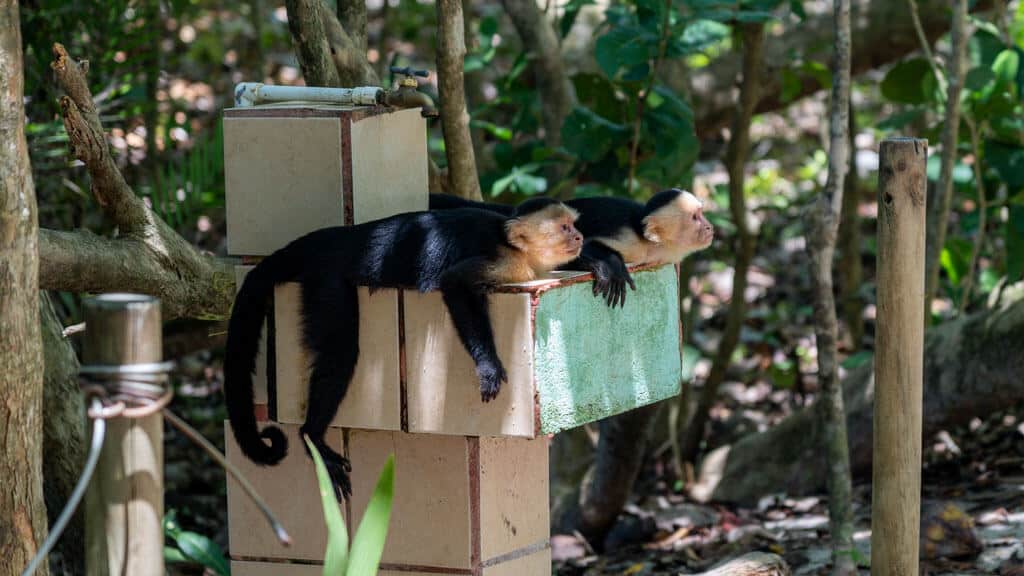
Manuel Antonio National Park opening hours
The Manuel Antonio National Park is open every day of the year except on Tuesdays. It is open on all holidays unless it falls on a Tuesday.
The park closes one day per week on Tuesdays to let the environment and wildlife rest.
The park opens at 7 am and closes at 4 pm.
However, the beaches inside the park close at 3 pm, to give people enough time to walk back to the entrance and depart by 4 pm.
When you purchase your ticket, you must choose a time slot to enter, the first is 7:00 am – 7:40 am, and the final time slot is from 1:00 pm – 2:30 pm (the only slot that is longer than 40 minutes).
You can arrive at any time within that slot (e.g. a 40-minute window).
When is the best time to visit Manuel Antonio National Park?
Time of year
In terms of the time of year, the dry season in Costa Rica is considered the best time to visit the park.
This is from November – April on the Pacific Coast in Manuel Antonio.
However, with this period comes lots of tourists, and as Manuel Antonio is a very popular destination it can be extremely crowded. Especially around holidays and in the peak months of December, January and February.
The wet season is usually from May – October. It doesn’t mean rain all day, every day, and the animals can often be more active when the weather is a bit cooler.
September and October are generally considered to be the wettest months, so I would suggest avoiding these times.
We visited in May and had a perfect day at the park, and it didn’t feel overly crowded.
Time of day
In terms of the time of day to visit the park, the earlier the better!
We would recommend selecting the first entry slot at 7 am, as this is the best time to see wildlife active before the heat of the day and to avoid a lot of the crowds.
If you’re planning to spend some time on the beach after walking on the trails (highly recommended!), you need to ensure you have enough time for this, remembering the beaches close at 3 pm. So you don’t want to arrive too late.
I know every blog advises you to arrive at tourist attractions early, but seriously arrive early.
Despite the limit on ticket numbers, Manuel Antonio can get seriously crowded and the best way to not see any nature is to be surrounded by big and noisy tour groups that start rolling in from around 10 am.
Because of this, we really recommend staying in Manuel Antonio. If you’re coming from Jaco (2 hours), Dominical (1 hour), or Uvita (1.5 hours), you’re going to need an incredibly early start to make it for a 7 am entry.
How long to spend in Manuel Antonio National Park
You could easily spend an entire day in the park. The hours are 7 am – 4 pm, and I think that’s the perfect amount of time.
With 11 trails to explore and a handful of beautiful beaches, you want to dedicate plenty of time to see everything.
If you follow our recommendation and enter the park at 7 am, it’s unlikely you would be ready to leave before at least 1 pm. And that would only really be allowing time to explore some of the trails, not time to relax on the beach.
We made some mistakes with food, so we had to leave earlier than we wanted to because we were so hungry. I’ll explain more about this below, but if you’ve brought food with you or the cafeteria is open, I would suggest allowing all day in the park, until 4 pm.
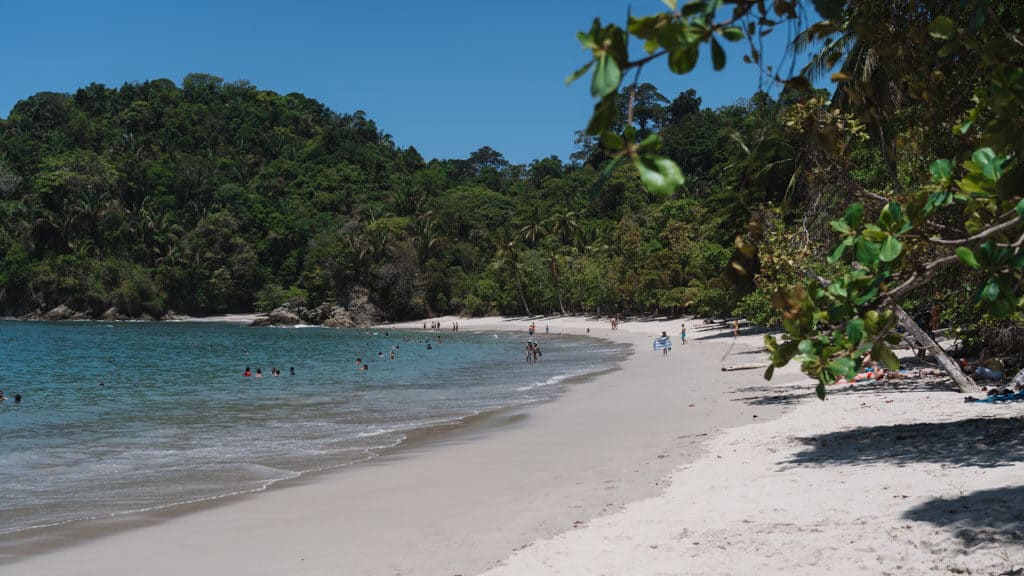
Manuel Antonio National Park entrance fee
The Manuel Antonio National Park entrance fee for foreign adults is $16 USD + IVA tax, which equates to $18.08 USD.
For foreign children aged 2 – 12 years old, it is $5 USD + IVA tax which equates to $5.65 USD. They will ask for evidence confirming the children’s age when entering the park.
You will pay for the tickets online via a credit card. The tickets are priced in USD, but when you checkout and pay, you will be charged the equivalent in Costa Rican Colones (CRC).
Buying Manuel Antonio National Park tickets
The most important thing to note is that you must buy your tickets online in advance. You can’t turn up at the park and buy your tickets on the day.
Tickets can only be purchased online via the SINAC website. This is the Costa Rican authority responsible for managing national parks.
The reason for this is that the park is very popular, so there are capacity limits each day to protect the flora and fauna.
Previously the number of visitors allowed in the park each day was 3,000 (a crazy number for such a small space!).
As of 2023, this number has been reduced to 1,120 people per day.
A certain number of visitors are allowed to enter the park each hour, with 40-minute entry slots. E.g. the first entry slot is 7:00 am – 7:40 am, the second is 8:00 am – 8:40 am and so on.
You can arrive at any time within your time slot (e.g. any time between 7:00 am and 7:40 am), so you’re not locked into being bang on time.
If you are planning to take a guided tour, be sure to check if it includes your entrance ticket to the national park. Some tours do, and some tours don’t. If you need to buy your own ticket to the park, make sure you can get your desired date and time before booking your tour.
🎟️ How to buy your tickets for Manuel Antonio National Park
- Go to the SINAC website
- Switch the language to English if required
- Create an account
- Log in with your username and temporary password
- Change your password
- Select ‘buy tickets’
- Input Manel Antonio National Park as your desired park
- Select your date and entry time slot
- Enter your personal details, including your passport number
- Make payment
You will be asked to show your entrance ticket (on your phone is fine) when you arrive at the park. They also ask to see the passport used in your booking to match your identity.
We brought our passports with us, but no one asked to see them in the end. But best to be safe, not sorry!
Whilst the reduction in daily visitors is fantastic news for the fragile natural environment and the wildlife inside the park, it does mean you have to be quick to secure your ticket. Especially if you want to visit early in the morning, during the peak season.
The reduction in tickets has created a bit of a mafia-style racket, with local organisations purchasing bulk tickets and reselling them at incredibly inflated prices to unprepared travellers.
Those travellers then get angry at the prices and have a negative experience. When really, all they needed to was research and purchase their tickets in advance. You won’t make the same mistake!
How far in advance should you purchase your tickets?
As far as you can. Especially if you want to arrive for the first or second slot in the morning.
If you’ve got a trip to Costa Rica planned to the tee, with all your accommodation pre-booked and everything locked in, book the tickets ASAP.
There’s no point waiting, and it’s best to secure your date and time slot as early as you can.
If you’re travelling on a looser schedule, you’ll still want to lock your tickets in at least a couple of days in advance. We missed out on tickets because we left it until the day prior, and there were no morning slots available.
If you’re visiting around holidays, or in the peak months of December, January and February, I would stretch this out to at least a week beforehand if you can.
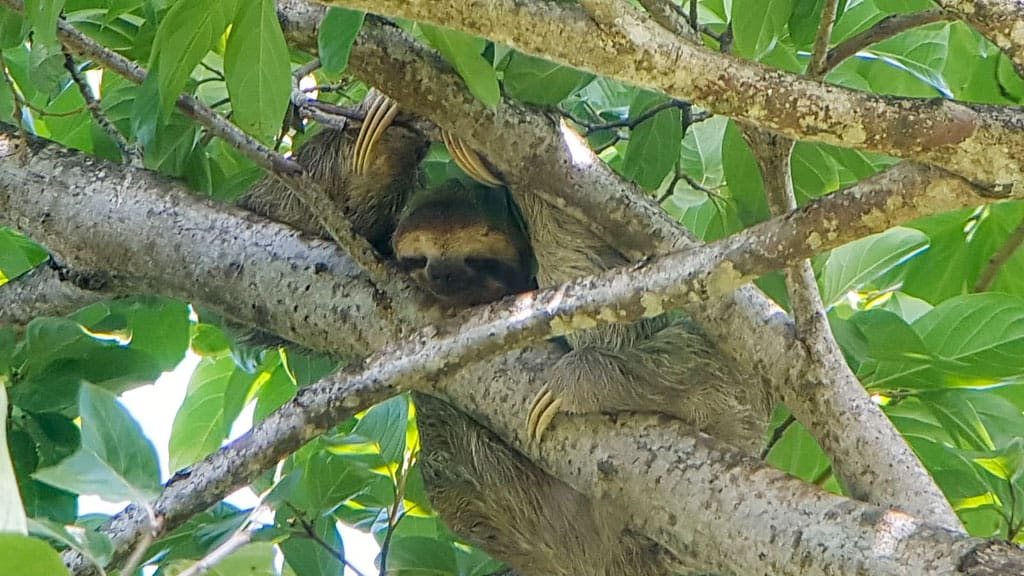
Do you need a tour guide for Manuel Antonio National Park?
No, the short answer is you do not need a tour guide to visit Manuel Antonio National Park.
So long as you have bought your ticket, you are free to explore the park on your own.
However, there is a lot of merit in hiring a guide, and there are a number of guided tours available. But I wouldn’t go as far as saying it’s not worth visiting without a guide, as that’s simply not true.
Guides are generally qualified naturalists who have a wealth of knowledge about the flora and fauna of the park. They also have years of experience spotting animals, with laser vision for seeing critters you never could have spotted on your own.
They carry a telescope which allows you to get a close look at animals high in the trees, and they can also take photos on your phone through the scope.
If Manuel Antonio National Park is one of the only national parks you are visiting in Costa Rica and is one of your only opportunities to spot wildlife, you should get a guide.
It is undeniable that they will be able to spot far more wildlife than you ever could on your own.
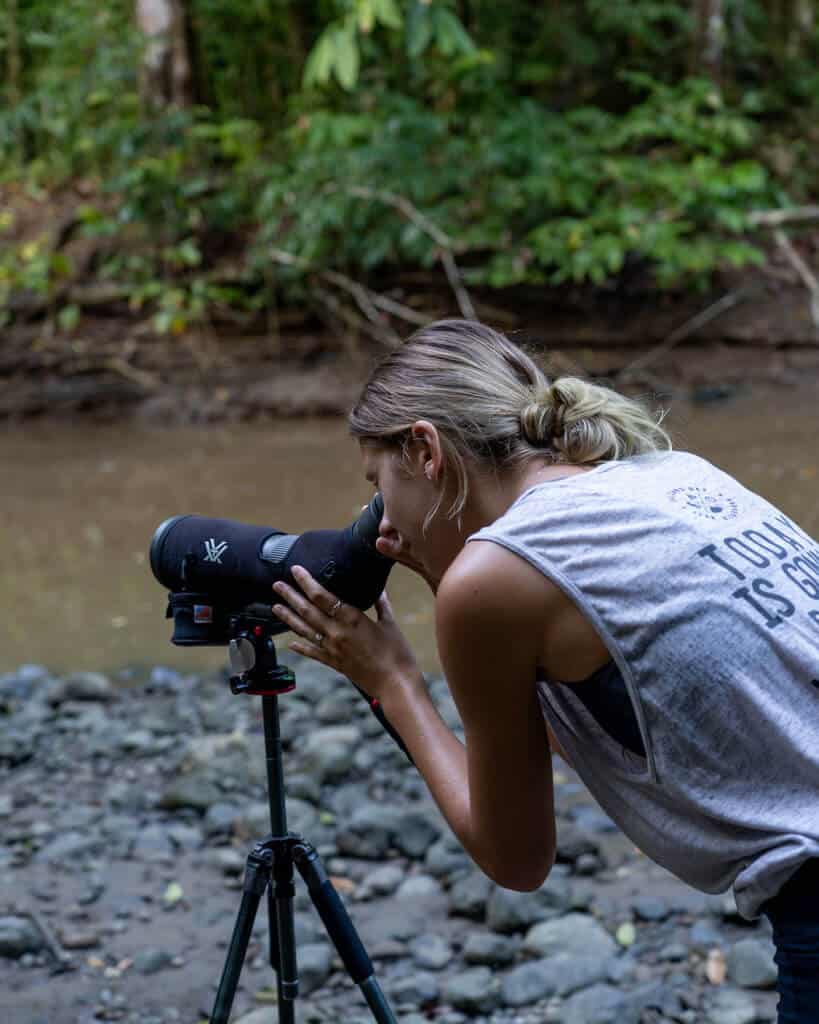
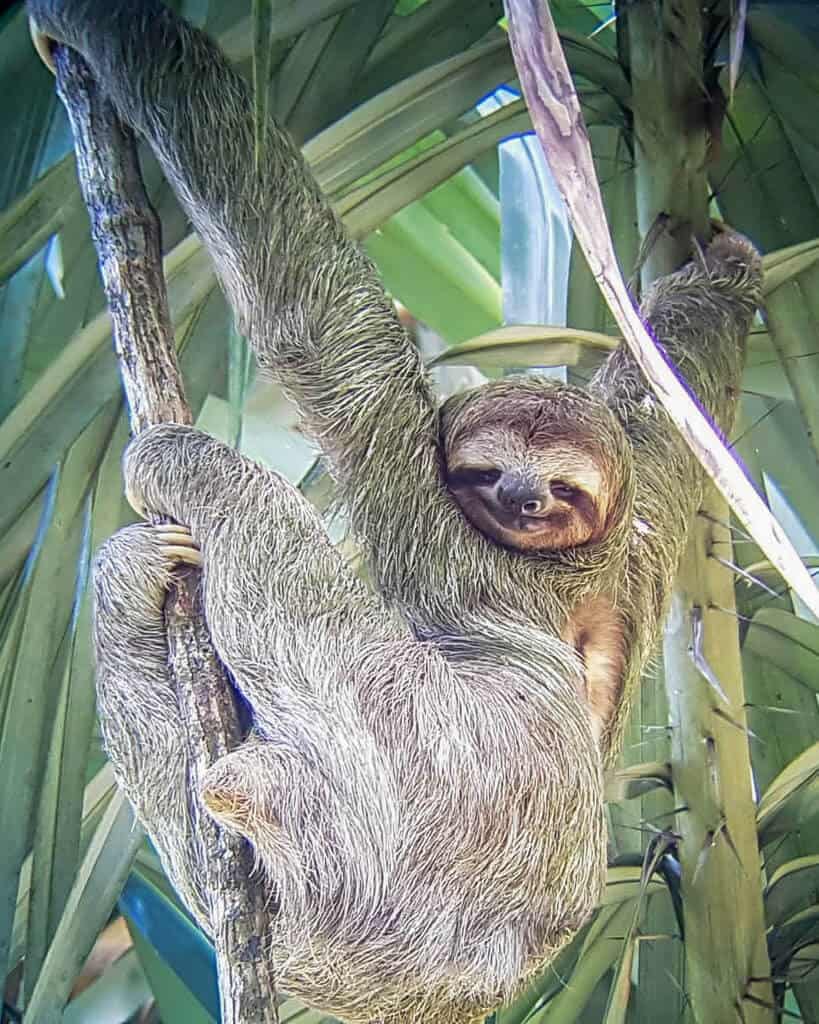
👎🏼 Why you wouldn’t get a guide
- You’re on a tight budget
- You don’t like being in large groups or on someone else’s schedule
- You’ve done some other guided wildlife tours in Costa Rica and have a good idea of what you’re looking for
- You have your own binoculars
Being on a tight budget, we decided not to get a guide for Manuel Antonio. We had been in Costa Rica for a few weeks at this point and had seen a bit of wildlife so we felt like we knew what we were looking for. We also knew we had a guided overnight tour of Corcovado National Park coming up, so we decided to save our pennies. We managed to spot a ton of animals on our own, but there were times when we took cues from guides and their groups to see a sloth!
👍🏼 Why you would get a guide
- You are really eager to see wildlife
- You aren’t taking a guided wildlife tour anywhere else in Costa Rica
- You are interested to learn facts and information about the park, its animals and plants
- You don’t have much other experience seeing wildlife around Costa Rica
Although we didn’t get a guide for Manuel Antonio, we highly recommend having at least one guided wildlife experience. I am still absolutely blown away by the knowledge our guide had at Corcovado National Park and we learnt so much more about the environment in Costa Rica. If you’re not going to Corcovado, get a guide here for sure!
Manuel Antonio National Park tours
If you decide you want to hire a guide, there are a number of ways to do this.
The simplest, but possibly riskiest, way is to turn up on the day and hire a guide at the gate. There are plenty of people standing outside the entrance offering their services.
I’m sure most are as qualified as they say they are, but you never really know when you’re organising it on the spot.
You want to have an expert, naturalist guide but there are stories of visitors ending up with unqualified guides who didn’t know anything or share any information about the park.
Instead, I would suggest booking a tour online in advance, where you can check previous reviews and confirm the qualifications of the guide.
Some are simply guided tours, where your guide will meet you at the gate. You’ll have to arrange your entrance ticket to the park.
Others are more inclusive tours that cover your entry ticket, possibly transport or car parking too. Be sure to confirm what exactly is included.
Most guided experiences last for 2 – 3 hours, and the guide will lead you on one or more of the trails.
Usually, the guides will end the tour at the beach, where you can stay on in the park unaccompanied for the rest of the day, and walk yourself back to the exit when you are ready.
Another thing to be wary of is how many people the tour is capped at. Are you booking a private tour for just you and your companions? Or are you joining a tour of possibly 20+ people?
We would recommend opting for a smaller group to give you more time on the telescope, and ensure you’re not moving too slowly.
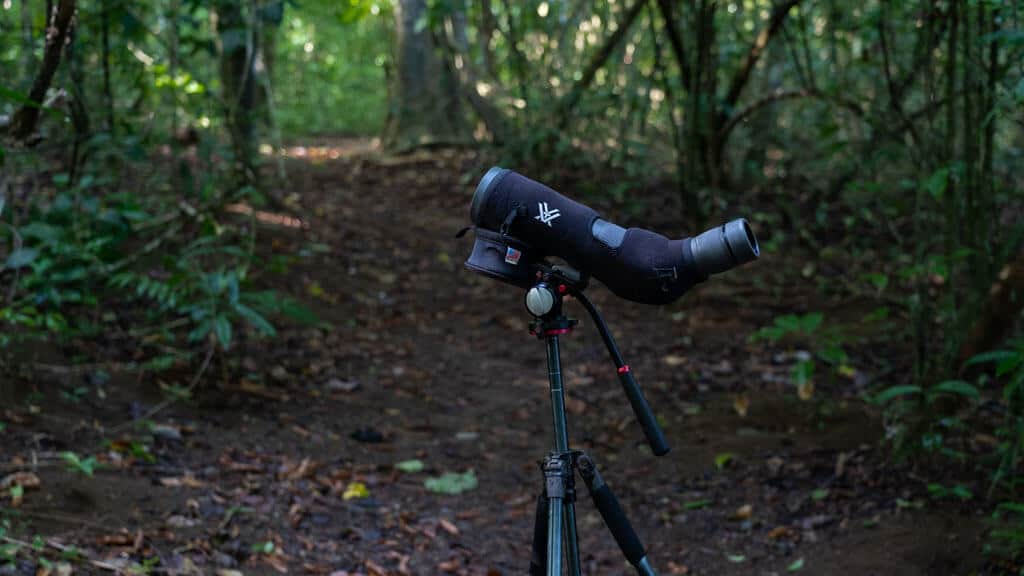
Here are a couple of our recommendations:
- Manuel Antonio Park Nature Guided Tour – this tour is a highly rated, premium option that is capped at 10 people. It includes pick-up from hotels in Quepos or Manuel Antonio.
- Manuel Antonio Park Tour – this highly rated option is a standard, 2-hour guided walk, and you will need to buy your own tickets. The guides will leave you at the beach, so you can continue to enjoy the park after the tour.
Top activities on Costa Rica’s Central Pacific Coast
Map of Manuel Antonio National Park
Hiking in Manuel Antonio National Park
There are 11 different trails for hiking in Manuel Antonio National Park.
If you’re an avid hiker, it’s possible to cover all of them in one day. If you’re after a better balance of walking and beach, you can just choose a handful of trails.
You can expect to hike through a number of different ecosystems across the park. Primary and secondary forest, mangroves and lagoons, sandy tropical beaches and coastal cliffs.
The trails are mostly flat and well-made gravel, concrete or wooden boardwalk. None of them are too difficult, with the exception of the Mirador Trail which has quite a few stairs.
Each offers a glimpse of a different ecosystem and has different wildlife viewing opportunities.
We’ve written a complete guide to hiking in the park, providing an overview of each trail, including the distance, terrain, difficulty and the wildlife you can expect to see.
Here’s a short list of the 11 trails. I’ve included a * next to the trails we think are unmissable!
- 1. Entrada Principal / Access Road*
- 💡 Best for – lots of wildlife and guided tours
- 🥾 Distance – 1.1 km / 0.7 mi
- 2. Sendero El Manglar / Mangrove Trail*
- 💡 Best for – wildlife and rainforest
- 🥾 Distance – 1 km / 0.6 mi
- 3. Sendero Perezoso / Sloth Trail*
- 💡 Best for – sloths and dense jungle
- 🥾 Distance – 600 m / 0.4 mi
- 4. Sendero Catarata / Waterfall Trail (seasonal)
- 💡 Best for – waterfall and frogs
- 🥾 Distance – 700 m / 0.4 mi
- 5. Sendero Mirador / Lookout Trail
- 💡 Best for – stunning views
- 🥾 Distance – 1 km / 0.6 mi
- 6. Sendero Los Congos / Howler Monkey Trail
- 💡 Best for – shortcutting and howler monkeys
- 🥾 Distance – 300 m / 0.2 mi
- 7. Sendero Puerto Escondido / Hidden Port Trail
- 💡 Best for – ocean views
- 🥾 Distance – 400 m / 0.25 mi
- 8. Sendero Playa Gemelas / Gemelas Beach Trail
- 💡 Best for – a quiet beach and monkeys
- 🥾 Distance – 400 m / 0.25 mi
- 9. Sendero Playa Manuel Antonio / Manuel Antonio Beach Trail*
- 💡 Best for – the park’s best beach
- 🥾 Distance – 400 m / 0.25 mi
- 10. Sendero Punta Catedral / Cathedral Point Trail
- 💡 Best for – ocean lookouts
- 🥾 Distance – 1.2 km / 0.75 mi (loop)
- 11. Sendero Playa Espadilla Sur / Espadilla South Beach Trail*
- 💡 Best for – quiet beach and shaded sandy trail
- 🥾 Distance – 1 km / 0.6 mi



Beaches in Manuel Antonio National Park
In addition to housing a dizzying number of wildlife, lush jungle and miles of trails, Manuel Antonio is known for its gorgeous beaches.
There are three beaches in the park that you can swim in.
Although the beaches inside the national park are gorgeous, there are a ton more outside the park’s boundaries that are worth checking out too! I’ve got a guide to the 7 best Manuel Antonio beaches, sharing more info on the conditions and amenities at each beach.
1. Playa Manuel Antonio
Playa Manuel Antonio is the most popular beach and for good reason!
It is a gorgeous bay with powdery white sand and sparkling blue waters that are perfect for swimming. Almond trees line the beach, providing shade to lay under.
I absolutely adored swimming and floating around on this beach, because it was so calm. Compared to other beaches in the park, and in Manuel Antonio more broadly, this beach was less wavey, without strong rips and currents and it had a sandy bottom, not rocks.
You do have to be careful, as there are still waves and currents, but it was far more gentle, and you could just roll with the waves without getting completely dumped.
Because of this, the beach does get busy. It will most likely be crowded when you visit, but we decided it was worth it for the calm waters. We spent almost an hour just floating in the water, and we couldn’t drag ourselves out!
Just a short walk from the beach are bathrooms and outdoor showers where you can rinse off the sand and salt before continuing on the trails.
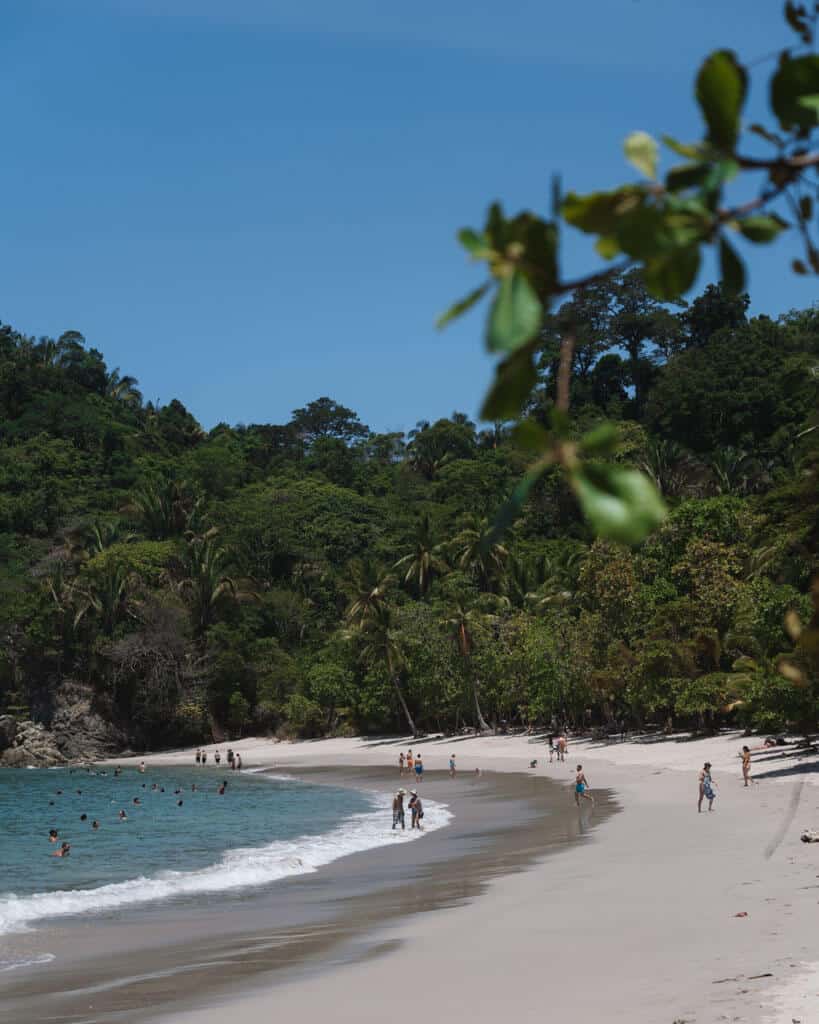
2. Playa Espadilla Sur
Just on the other side of the peninsula is Playa Espadilla Sur. This is a natural extension of Playa Espadilla Norte, which is accessible outside of the national park.
This beach is a lot bigger than Playa Manuel Antonio and feels as if it sweeps on forever. It has the same powdery sand and blue waters, but the waves are not as calm here. The rip tides are strong, and it can be dangerous for swimming if you’re not experienced.
There are dedicated access points to the beach from the trail, with ropes blocking the rest of the way, so if you want to get out on the sand, enter at the start or end of the trail.
There are toilets, change rooms and somewhere to wash your feet at the connection to the Manglar Trail. Or you can just as easily walk back to Playa Manuel Antonio to use the facilities there.
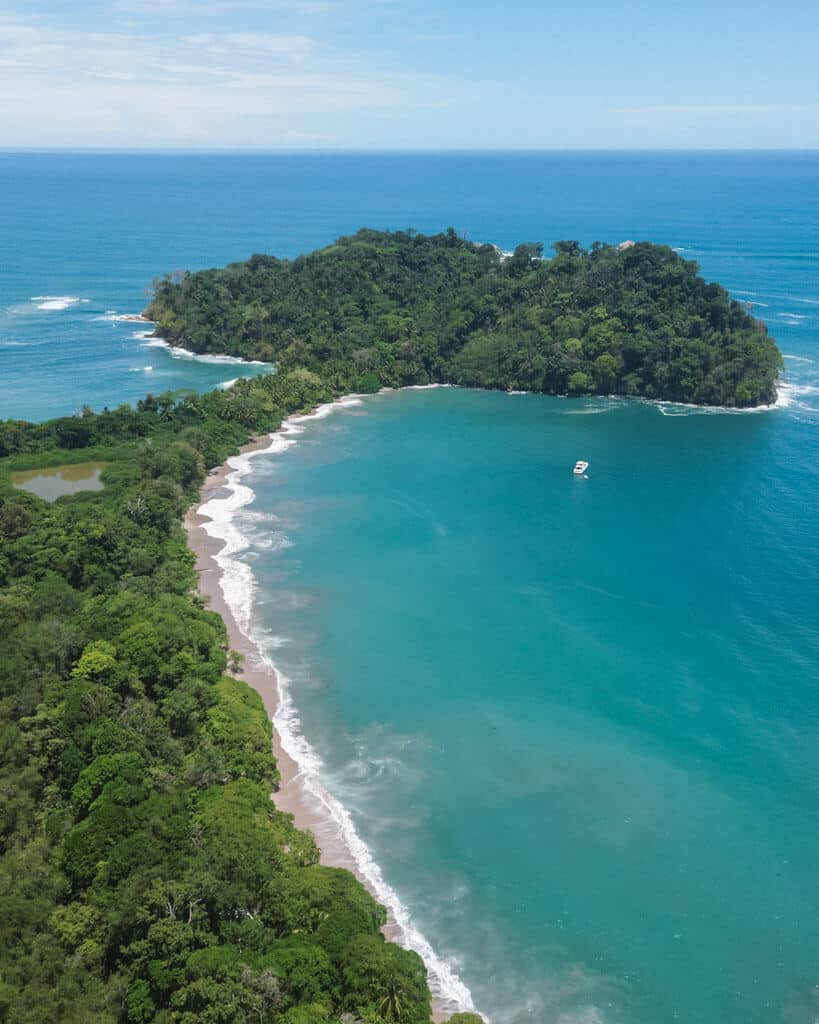
3. Playa Gemelas
Meaning ‘the twins’ in Spanish, Playa Gemelas is in a different section of the park to the other two beaches. It’s often empty and is a much quieter and more peaceful option than the alternatives above.
This beach is actually made up of two separate coves separated by some rocks. At low tide, you can easily walk between the two.
The beach is gorgeous, but the waves and rip currents are very strong here, so swimming isn’t advised.
We saw a whole troop of capuchin monkeys come down onto the sand here. They were wrestling and playing with each other, and running, jumping and swinging around like crazy!
Some of the monkeys were picking on an iguana that was on the beach, and others were harassing tourists trying to get into their bags.

Animals in Manuel Antonio National Park
Manuel Antonio National Park is full of creatures big and small. It really is brimming with animals, and it’s one of the best places in the whole country to spot some of Costa Rica’s famous wildlife.
Here’s some of the most common wildlife you can expect to spot in the park:
- 🐵 Capuchin monkeys
- 🐒 Howler monkeys
- 🐿️ Squirrel monkeys
- 🦥 Sloths
- 🦫 Agoutis
- 🦌 White-tailed deer
- 🦝 Racoons
- 🦡 Coatis
- 🐤 Toucans
- 🦜 Macaws
- 🐦⬛ Hummingbirds
- 🐸 Green poison dart frogs
- 🦎 Iguanas and lizards
- 🐍 Snakes
- 🐊 Crocodiles and caimans
- 🦀 Crabs
- 🐜 Leafcutter ants
We have a full post dedicated to the animals in Manuel Antonio National Park. If you’re a wildlife fanatic like me, I’ve shared more information about the most common species that live in the park, and where to find them!

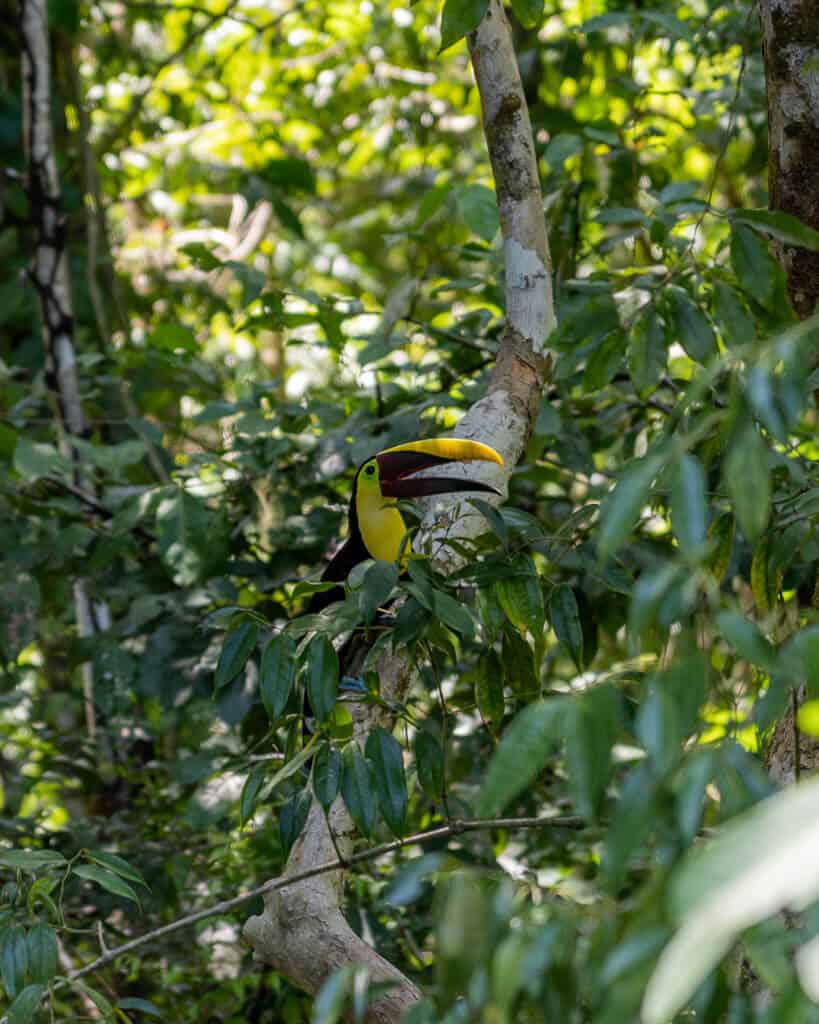

How to plan your day at Manuel Antonio National Park
We felt like we had a pretty good plan and route throughout the park, that covered most things we wanted to see and do without backtracking too much.
We did this without a guide, but I’ll provide an adaptation below if you are going to take a guided tour.
If you’ve got a whole day to give and you want to see as much of the trails, wildlife and beaches as possible, here’s our suggested plan:
- Book your tickets for the first entrance at 7:00 am – 7:40 am
- Waterfall Trail first if you want to do it and it’s the right season
- Continue into the park on the Access Road
- Toilet break near the cafeteria
- Mirador Trail to the two lookouts
- Cut across the Los Congos Trail to the Puerto Escondido/Playa Gemelas Trail
- Continue to the Puerto Escondido Lookout (if it’s open)
- Stop at Playa Gemelas, swim if you want
- Head back along the Puerto Escondido Trail to the junction
- Walk down the Sloth Trail and return the same way you came (the only backtrack)
- Eat lunch at the café (if it’s open), use the bathrooms
- Head to Playa Manuel Antonio to swim and relax, eat your lunch (if you packed it)
- Cross to Playa Espadilla Sur if desired
- Rinse off in the showers near Playa Manuel Antonio
- Hike the Punta Catedral Trail (if it’s open)
- Head back towards the entrance via the Playa Espadilla Sur Trail
- Connect with the Manglar Trail and take that all the way to the entrance
- Done!
If you want to take a guided tour (which we definitely recommend doing at least once around Costa Rica) you’ll need to adapt a little.
I would recommend booking your tour for first thing in the morning at 7 am. Your guide will most likely take you along the Access Road or via the Manglar and Sloth Trails. The tours only go for 2 – 3 hours, so ask your guide to leave you at the junction near the café.
From there, hike the Mirador/Los Congos/Puerto Escondido/Playa Gemelas combo, and loop back to the junction. Hit the beaches from there, and hike the Punta Catedral Trail if you have time and energy.
Decide which route to take back, pending which trails you hiked with your guide. You might follow our suggestion of the Espadilla Sur/Manglar Trail combo, or you might like to head back to the junction and use either the Access Road or the Sloth/Manglar Trail combo to get back to the entrance.
What to wear to Manuel Antonio National Park
No matter what time of the year you visit, you can expect the weather to be warm and humid.
We recommend wearing light, sport-style clothing that you are comfortable walking in. Shorts, a T-shirt or shirt for sun protection and a hat is a good choice.
You could also come wearing your swimwear if you want to, although there are changerooms near the beach.
None of the trails are overly strenuous, so you don’t need to wear hiking boots. Runners are advised, or hiking sandals if you’re comfortable in them.
Bear in mind that you will be hitting the beach too, so you might prefer a shoe that can get wet and sandy. I wore my Teva sandals and was totally comfortable.

What to bring to Manuel Antonio National Park
I want to start this section with what you can’t bring into the national park.
Being an area with high biodiversity and a large concentration of wildlife, the park is (thankfully) very strict about what you can bring in with you.
Visitors are not allowed to bring:
- 🥤 Single-use plastic bottles
- 🍟 Food with plastic or waste of any kind attached (chip packets, fruit with inedible peel, wrapping or packaging)*
- 🍺 Alcohol
- 🚬 Cigarettes and e-cigarettes
- 🚁 Drones (all drone photos in this post were taken outside the park)
- ⛱️ Beach chairs and umbrellas
- 🧊 Coolers
- 🔊 Speakers
Your bags will be checked as you enter, so don’t think you can sneak anything in. You can’t.
*A whole section on the complex issue of food is coming below!
This is what you should bring to Manuel Antonio National Park:
- 💧 A reusable water bottle – filled with water. This is permitted, and there are refill stations around the park with safe drinking water.
- 👙 Swimwear – come wearing your swimmers, or change at the changerooms near the beach.
- 🧖🏽♀️ Towel – to laze on the stunning beaches and dry off. There are showers to rinse off too.
- 🧢 Sun protection – a lot of the trails are shaded, but the beaches don’t have a ton of sun protection. Sunscreen (natural!), hat, and shirt to cover your shoulders.
- 🍍 Snacks – a complicated issue to be discussed below, but I think you should pack snacks.
- 🎒 Waterproof bag – rain is possible at any time in Costa Rica. If you don’t want to lug around a raincoat, at least carry a bag that can get wet and keep your belongings safe.
- 🛂 Passport – used to verify your identity in comparison to your tickets.
Food in Manuel Antonio National Park
I want to preface this section with a disclaimer. The issue of food in the park seems to change often. I can only share the experience we had in 2023 and hope that it is still accurate for you at the time of your visit. I would encourage you to check out recent reviews right before your visit or to speak with your accommodation in Manuel Antonio to get the latest on the food situation.
There is so much conflicting information out there about food in Manuel Antonio National Park.
There has always been a small kiosk/cafeteria inside the park, where you could buy basic meals and snacks. You could only eat inside the kiosk, to avoid the animals stealing food or being fed. You were not allowed to bring any of your own food.
To date, the park’s website confirms this, saying that there is absolutely no food permitted inside the park.
We followed these instructions.
I had previously read on a few blogs that you could bring pre-prepared food like sandwiches and chopped fruit in reusable containers, but I thought the info on the official website would trump this.
I was wrong.
When we visited, the cafeteria inside the park was temporarily closed. We saw this sign below, stating that the cafe’s contract had expired. Because of this, you were allowed to bring food with you into the park. You could only bring food that was pre-made with no plastic, packaging or waste on it.

For example, you could bring:
- A pre-made sandwich in a reusable container
- Apple chopped up in a reusable container
However, you could not bring:
- A sandwich in plastic wrap, a paper bag or any kind of disposable wrapping
- Fruits like mango or watermelon with a peel that cannot be eaten (unless you have chopped it off)
My understanding is that as long as the cafeteria inside the park remains closed, you are allowed to bring this type of food inside the park. If it reopens, you possibly can’t bring food.
Most people want to spend the entire day in the park. If the cafeteria is closed, it’s unreasonable to expect people to last all day hiking in the heat without any food.
My recommendation is to pack food that meets the above criteria for your visit, on the chance that the cafeteria is still closed.
The worst case is that they have reopened the café, and they may not allow you to bring the food. They will give you the opportunity to eat it before you go in or throw it out at the entrance.
Don’t spend too much on anything fancy, but in my opinion, it’s worth having both your bases covered so you’re not rushing out of the park because you’re starving, as we were.
Where to stay near Manuel Antonio National Park
As we recommend basing yourself in Manuel Antonio for a few days, you’ll need somewhere to stay! The area has more than just the national park, and we would suggest a minimum of 2 – 3 nights here. There are some recommendations below, depending on your budget.

Hotels near Manuel Antonio National Park
There are a number of amazing hotels all over the Manuel Antonio area, and I share some of the best picks in my Manuel Antonio guide post. But here, I would like to specifically highlight some options that are within easy walking distance of the park entrance.
- La Posada Jungle Hotel – you cannot get any closer to the park entrance than this option! A simple but well-maintained hotel with jungle vibes, and tons of wildlife! There is a swimming pool, and the rooms are spacious and well-equipped.
- $100 USD + per night check prices here
- Hotel Playa Espadilla & Gardens – a gorgeous resort-style hotel with large and well-equipped rooms, tropical grounds and a swimming pool. In a perfect location to walk to the park, as well as to Playa Espadilla Norte. Very well rated.
- $180 USD + per night check prices here
- La Vela Boutique Hotel – the pick of the bunch near the park, this stunning hotel is sleek and modern. The grounds ooze tropical vibes and there is a large swimming pool. The suites are worth splurging for, with a spacious covered balcony with jungle views. Daily breakfast included.
- $200 USD + per night check prices here
Hostels near Manuel Antonio National Park
If you’re on a budget it can be a little trickier, as the area is quite affluent, with a lot of luxury hotels. But there are a few hostels around, although none of them are within walking distance of the park, unfortunately. These are the closest and best-rated options.
- Teva Jungle Hotel and Hostel – an eco-style hostel nestled into the jungle near the centre of town. The property has a huge nature reserve attached with miles of trails to explore. There are dorms and privates, an on-site pool, a communal kitchen and a restaurant.
- $10 USD + per night check prices here
- Selina Manuel Antonio – a solid option, the Selina here is just as good as all their other properties around Costa Rica. Privates and dorms are available, and the property is huge and blended into the jungle. There’s a pool and all the usual Selina amenities on-site.
- $20 USD + per night check prices here
- Hostel Plinio – closer to Quepos than the park, this highly rated option is loved by travellers. A true jungle setting with a large swimming pool, daily breakfast and a communal kitchen. There are dorms and private rooms.
- $15 USD + per night check prices here
I hope this post has prepared and excited you for an amazing day at Manuel Antonio National Park. From the gorgeous hiking trails to the unique wildlife and stunning beaches, it’s no wonder this is Costa Rica’s most popular park. Don’t miss it!
More Manuel Antonio guides




The Comments
Laurie
Great article. Covers everything a visitor needs to know in a concise, easy formate. Thanks
Sally Rodrick
LaurieThanks for your kind words Laurie. So glad it was helpful. Enjoy – I hope you see tons of animals! Sally
Melind
Hi if you don’t arrive until later than your reservation do they turn you away?
Sally Rodrick
MelindHi Melinda, as a general rule, I would plan on them turning you away if you don’t arrive within the 40 minute window of your time slot. Particularly in peak times when they are selling out each hour. In reality, you may get lucky but it would totally depend on the day, how busy the park was and how friendly the person at the gate was feeling. Choose a time slot you can arrive on time for. Sally
Moxileira
This is an insanely good, well-written and informative article. Thank you so much, we’ll be going there in about 2 weeks and this is pure gem. Brazilian regards <3